How did American ideals influence our role in global conflict?
World War I, known as the Great War at the time, broke out in 1914 with Germany and Austria-Hungry on one side and Great Britain, France and Russia on the other. Most Americans wanted to keep the United States out of the conflict and saw rivalries among European aristocracies as the cause of the fighting. While the U.S. was neutral, the country did want to continue to carry on trade with Europe. This created a problem because the warring nations did not want American manufactured products and farm goods to reach their enemies. Great Britain’s navy prevented most American ships from reaching German ports. In response, Germany began using submarines to attack any vessel taking supplies to its enemies. In 1917, when German submarines began sinking American ships, the U.S. declared war on Germany and its partners. American soldiers joined the fighting.
United States Enters World War I
The United States was not prepared for war. It had to raise an army quickly and to supply it with arms, food, clothing and transportation. That required a major effort from the entire population. Young men were required to register for military service, and the army began drafting men into uniform. Iowa recruits were often sent to Camp Dodge, a hastily-built training center just north of Des Moines. Today, it is the headquarters of the Iowa National Guard. Iowa factories began making armaments and munitions (bullets and explosives) and other war equipment.
A big challenge was to feed U.S. soldiers and our allies, particularly Great Britain and France. To encourage farmers to produce more, the government guaranteed them high prices for their products and appealed to their patriotism. Posters declared "Food Will Win the War." It worked. Iowa farm production took a huge upward surge. As farms produced more, all families were encouraged to use less. Sugar, butter and meats were rationed (limited). Each family got a ration book with stamps that they could use to buy limited amounts of certain products each week. Families were encouraged to plant "Victory Gardens” to produce more of their own food, and Iowans responded enthusiastically.
The government sold bonds to pay for the war. A bond was a loan to the government that paid interest. To encourage sales, local committees in each town sponsored bond drives with patriotic rallies and door-to-door contacts. Even children saved coins and traded them in at the post office to secure a bond. The Red Cross was a semi-private organization that provided entertainment, refreshments and personal items to troops abroad. Women knitted scarves, socks and gloves for the troops with wool provided by the American Red Cross. Like the government, the Red Cross needed funds, and Iowans contributed readily to the cause.
Iowans Face Conflicted Loyalties
At the time, many Iowans still had ties to their European homelands. Germans and Irish were the two largest immigrant groups in the state, and neither was friendly toward Great Britain. The German language was still spoken in some communities, especially in western Iowa and Mississippi River cities like Davenport and Dubuque. In many communities, Germans, especially, were accused of supporting America’s enemies and were treated badly. They were forced to purchase war bonds, to kiss the American flag in public or humiliated in other ways. Schools were forbidden to teach the German language and German books were burned. Iowa’s Governor William Harding even issued the Babel Proclamation, which made it illegal to speak any language except English is public, but his act was not always taken seriously.
When fighting ended in November 1918, wild celebrations broke out almost everywhere with bonfires, speeches and revelries. Troops returning home had experienced a wider world than they had known before and were sometimes ready for new adventures. A very serious outbreak of the flu in November and December took the lives of more Iowans than were killed in combat. The war was over but the world was not the same as it was in 1914. The conflict had been called "the war to end all wars," but sadly, that was not to be the case.
Supporting Questions
Why did the United States hesitate to get involved in World War I?
- "Watch Your Step," 1914 (Political Cartoon)
- U.S. Neutrality Proclamation, August 6, 1914 (Document)
- "All Depends on the Point of View," September 1914 (Political Cartoon)
- Reverend Mercer Johnston's Letter to His Father During the War, October 12, 1914 (Document)
- Woman's Peace Party Letter to President Woodrow Wilson, October 29, 1915 (Document)
- "Wake Up, America, 1917 (Image)
- "Iowa Senators Have Defenders" Newspaper Article, March 7, 1917 (Document)
How effective were the contributions by the United States in WWI?
- "Invasion of Belgium by the 'Uncultured'," 1914 (Political Cartoon)
- "The Battle Fronts of Europe," 1917 (Map)
- "What America Has Done in Half Year of War" Newspaper Article, October 5, 1917 (Document)
- American Soldiers Heading into Action in the Argonne Forest in France, 1918 (Image)
- "From the Battlefields of France" from General John J. Pershing, 1918 (Audio)
- "We Laid Our Idle Pleasures Down Until We Won" Song Sheet, 1919 (Document)
- "Hoover the Humanitarian" Campaign Flyer, 1928 (Document)
Why did the United States retreat from global interactions following WWI?
- President Woodrow Wilson's Shorthand Speech Notes for his "Fourteen Points" Address, January 8, 1918 (Document)
- "League of Nations" Speech by Henry Cabot Lodge, 1919 (Audio)
- Albert B. Cummins Speech on the League of Nations, February 1919 (Document)
- "Americanism" Speech by Franklin Delano Roosevelt, 1920 (Audio)
- "Readjustment" Speech by Warren G. Harding, 1920 (Audio)
| World War I: Evaluating America's Role in Global Conflicts Source Set Teaching Guide |
| Printable Image and Document Guide |
"Watch Your Step," 1914
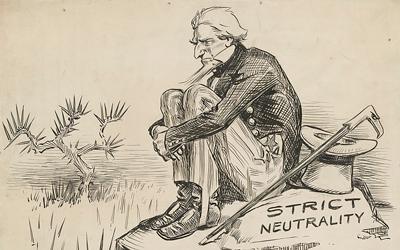
Description
This political cartoon shows a depiction of Uncle Sam sitting on a rock with the words "strict neutrality" written on the side. Beneath the rock is a circle of bayonets surrounding the rock.
U.S. Neutrality Proclamation, August 6, 1914
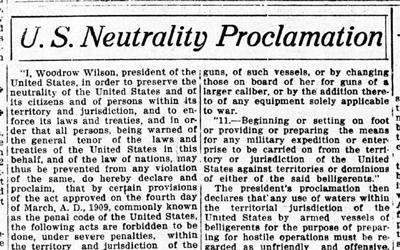
Description
This article from the Ottumwa Tri-Weekly Courier is a reprinting of the U.S. Neutrality Proclamation at the start of World War I in Europe. The proclamation outlines President Woodrow Wilson’s acts to preserve the neutrality of the United States.
"All Depends on the Point of View," September 1914
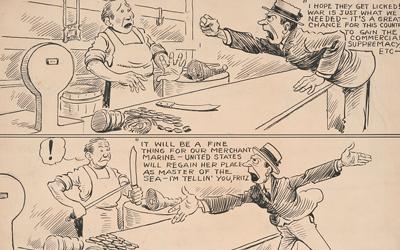
Description
Minnesotan Frank Naughton presents two arguments revealing American interests in seeing the European war continue in his three-panel editorial cartoon, which he drew for the Duluth News Tribune weeks after the war's start. Duluth, where immigrants made up…
Reverend Mercer Johnston's Letter to His Father During the War, October 12, 1914
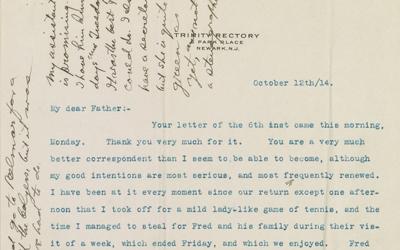
Description
Reverend Mercer Johnston was the rector of Trinity Church in Newark, New Jersey. In this letter to his father, Johnston expressed his strong opposition to Germany's role in the war and the desire to do what he could to "hasten Germany's day of judgment." Johnston…
Woman's Peace Party Letter to President Woodrow Wilson, October 29, 1915
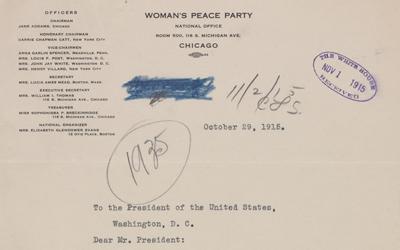
Description
The Woman's Peace Party, organized in January 1915 and led by Jane Addams, was one of the most prominent organizations opposing American military intervention and the preparedness movement. In this 1915 letter to President Woodrow Wilson, the party leaders argued that…
"Wake Up, America," 1917
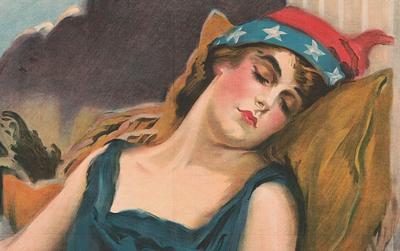
Description
This poster shows a woman dressed in stars and stripes, and symbolizes a sleeping America. After two and a half years of neutrality, the United States entered World War I on April 6, 1917. James Montgomery Flagg created this poster, which was featured in "Wake Up,…
"Iowa Senators Have Defenders" Newspaper Article, March 7, 1917

Description
This article that appeared in the Evening Times-Republican, a newspaper from Marshalltown, Iowa, outlined support for Iowa's senators in opposing the armed neutrality bill and opposition to the senators' actions to not speak to Iowans in the Iowa…
"Invasion of Belgium by the 'Uncultured'," 1914
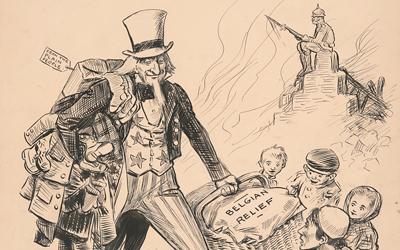
Description
This drawing shows Uncle Sam carrying a basket labeled "Belgian Relief" and an armful of clothing labeled "From the Plain People," taking a large step into the midst of a destitute woman and several children. These people symbolize the victims of the German invasion of…
"The Battle Fronts of Europe," 1917

Description
This map shows the area between Europe's western and eastern fronts overlaid over a map of the United States.
"What America Has Done in Half Year of War" Newspaper Article, October 5, 1917
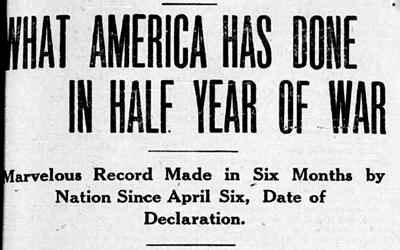
Description
This newspaper article appeared on the front page of the Keokuk newspaper, The Daily Gate City and Constitution-Democrat. The article outlined the impact the United States has had on the war effort. It also focused on the country's lack of…
American Soldiers Heading into Action in the Argonne Forest in France, 1918
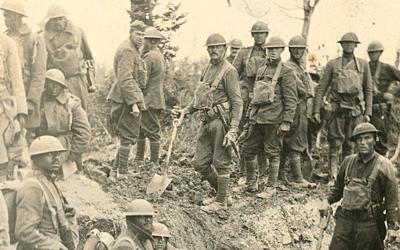
Description
This photograph shows engineers of the 302nd Engineer Regiment repairing a roadway over a trench. It also shows African-American soldiers of the 92nd Infantry Division, also known as Buffalo Soldiers, in a trench headed into action in the Argonne Forest in France during…
"From the Battlefields of France" from General John J. Pershing, 1918
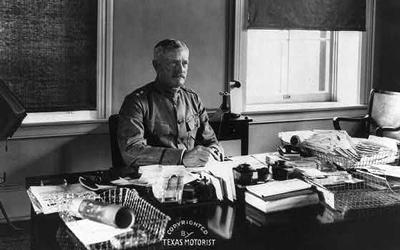
Description
This recording is a patriotic appeal by the U.S. Army to Americans for "their unshrinking support" during World War I. It was delivered by General John J. Pershing, chief of the American Expeditionary Forces.
"We Laid Our Idle Pleasures Down Until We Won" Song Sheet, 1919

Description
This sheet music is for the song "We Laid Our Idle Pleasures Down," which was written at the end of the war in 1919.
"Hoover the Humanitarian" Campaign Flyer, 1928
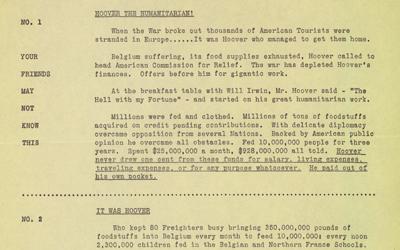
Description
Information on Herbert Hoover's humanitarian efforts during World War I. This flyer was used as campaign literature for his 1928 presidential campaign.
President Woodrow Wilson's Shorthand Speech Notes for his "Fourteen Points" Address, January 8, 1918
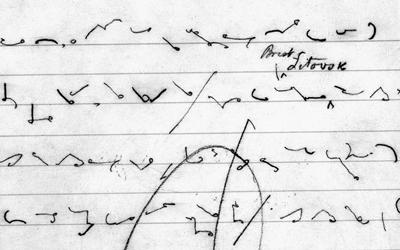
Description
In this January 8, 1918, address to Congress, President Woodrow Wilson proposed a "Fourteen Points" program for world peace. This document includes the shorthand speech notes from Wilson's "Fourteen Points" address. These points were later taken as the basis for peace…
"League of Nations" Speech by Henry Cabot Lodge, 1919

Description
This recorded speech is by Henry Cabot Lodge, a U.S. congressman from Massachusetts. In the speech, Lodge voices his opposition to joining the League of Nations.
Albert B. Cummins Speech on the League of Nations, February 1919

Description
This is a copy of Iowa U.S. Senator Albert B. Cummins' speech before a joint session of Congress. The focus of the speech is about the League of Nations' constitution.
"Americanism" Speech by Franklin Delano Roosevelt, 1920
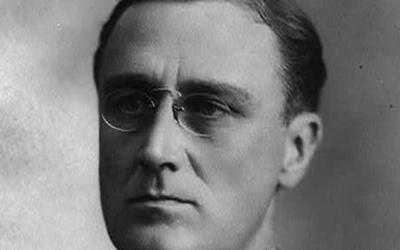
Description
Franklin Delano Roosevelt, former assistant secretary of the Navy, is speaking of those who fell in battle. "To them we must write the binding finish: it shall not happen again. Americans demand: the crime of war shall cease."
"Readjustment" Speech by Warren G. Harding, 1920
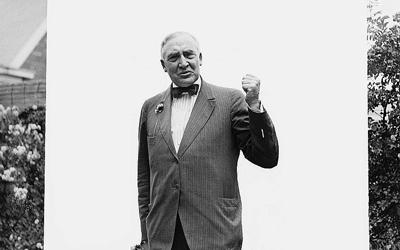
Description
The audio is from a speech by Warren G. Harding. Harding is calling for a return to normalcy following the end of World War I.
Additional Resources
- Echoes of the Great War: American Experiences of World War I
This Library of Congress exhibition considers the debates and struggles that surrounded U.S. engagement in World War I with numerous multimedia pieces to explore. - Iowa in World War I
This website from The Iowa Heritage Digital Collection focuses on Iowa's involvement in the war effort of World War I. - Iowa Public Television's "Iowa in World War I"
This IPTV website features photos, video and text showing Iowa's contributions during World War I. - The War of the Nations
This Library of Congress portfolio feature military-related etchings from 1914 to 1919. - Statistics on Mobilization of Soldiers During World War I
This website is part of a Library of Congress online collection focusing on World War I. This particular webpage features mobilized strength and casualty losses by country during WWI.
Iowa Core Social Studies Standards (9-12th Grade)
Listed below are the Iowa Core Social Studies content anchor standards that are best reflected in this source set. The content standards applied to this set are high school-age level and encompass the key disciplines that make up social studies for 9th through 12th grade students.
| No. | Standard Description |
| SS-US.9-12.19. | Examine how imperialism changed the role of the United States on the world stage prior to World War I. |
| SS-US.9-12.21. | Analyze change, continuity and context across eras and places of study from civil war to modern America. |
| SS-US.9-12.26. | Determine multiple and complex causes and effects of historical events in American history including, but not limited to, the Civil War, World War I and II, the Korean War and the Vietnam War. |
| SS-US.9-12.27. | Evaluate Iowans or groups of Iowans who have influenced U.S. History. |
| SS-WH.9-12.18. | Assess impact of conflict and diplomacy on international relations. |
| SS-WH.9-12.24. | Examine and explain how the perspectives of individuals and societies impact world history. |
| SS-WH.9-12.25. | Determine multiple and complex causes and effects of historical events within world history. |
| SS-WH.9-12.26. | Assess Iowans or groups of Iowans who have influenced world history. |
| SS-Geo.9-12.17. | Analyze how environmental and cultural characteristics of various places and regions influence political and economic decisions. |
| SS-Geo.9-12.22. | Evaluate how economic globalization and the expanding use of scarce resources contribute to conflict and cooperation within and among countries. |
| SS-Gov.9-12.20. | Explain the significance of civic values to a well-functioning democracy including concepts such as conviction vs. compromise, majority rule vs. minority rights, state interests vs. individual interests, rights vs. responsibilities, and other related topics. (21st century skills) |
| SS-Gov.9-12.23. | Evaluate multiple procedures for making governmental decisions at the local, state, national, and international levels. (21st century skills) |